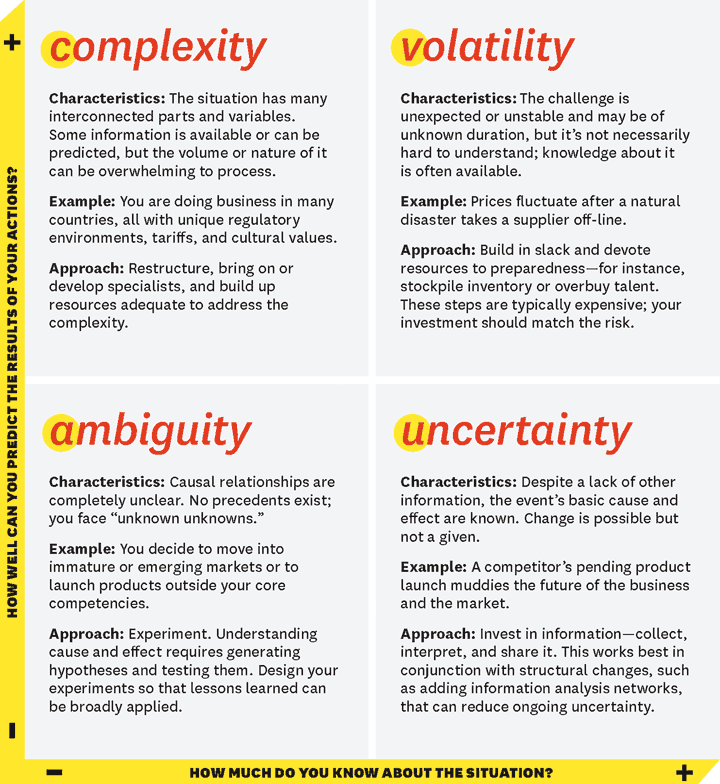
What the heck is VUCA, you might ask?
VUCA is an acronym that stands for Volatility, Uncertainty, Complexity, and Ambiguity, combining four distinct challenges that have four respective responses. It’s generally used as a catchall for “whoa, it’s crazy out there!”—perfect for how we’re feeling right now.
Let’s explore all four aspects of VUCA as something your team members (and quite likely you) are experiencing right now and how your business can respond to each.

Image via Harvard Business Review
Exploring VUCA
Volatility
Volatility occurs when something is unexpected and/or unstable and may last for an unknown duration (in other words, exactly what we’re experiencing now!). Compared to other aspects of VUCA, volatile situations are not necessarily hard to understand as information is often readily available. As contributing writer to Forbes Jeroen Kraaijenbrink puts it, “The more volatile the world is, the more and faster things change.”
So how can we deal with volatility? A lot depends on how prepared our organisations were before volatility struck, which means a proactive, as opposed to reactive response, is better when it comes to volatility. For example, if your organisation was already part-time or full-time remote—meaning you already had all the tools in place in order for your employees to work from home—then the volatility presented by the current circumstances would be easier to manage. For those having to take a reactive approach, however, now’s the time to start preparing for the months to come. Since we don’t know how long this situation could continue, getting the tools, communication practices, remote work standards, etc. in place for your business now can help make the path ahead much smoother and less volatile.
Uncertainty
This is probably one of the most challenging aspects of VUCA—at least it is for me! As Harvard Business Review (HBR) puts it, uncertainty can be characterized by the following: “Despite a lack of other information, the event’s basic cause and effect are known. Change is possible but not a given.”
In order to deal with uncertainty, companies can “invest in information—collect, interpret, and share it.” HBR continues by noting that “this works best in conjunction with structural changes, such as adding information analysis networks, that can reduce ongoing uncertainty.” By obtaining as much information as possible regarding what this new change in circumstance will mean for your company, and sharing that information with your team members, your employees will have more clarity as to where your organisation—and where they themselves—stand.
Complexity
A complex situation is one in which the situation has many interconnected parts and variables. “Some information is available or can be predicted, but the volume or nature of it can be overwhelming to process.” Exactly.
The best way to handle complexity is to first build up resources adequate to address said complexity. What resources do you already have that can help you out? What do you need to go out and search for? Do you need to hire or develop a specialist who can simplify your business’s specific complexity in house? Do parts of your organisation need to be restructured in this new climate?
Ambiguity
Ambiguity is also a great way to describe the current situation, one is which “no precedents exist; you face ‘unknown unknowns.’”
So what can you do? Explore. Now is the perfect time to test out new ways of working together and collaborating as a team. After all, as HBR notes, “understanding cause and effect requires generating hypotheses and testing them.” However, make sure you design your experiments “so that lessons learned can be broadly applied.”

What’s one exploration project you can run? Implementing a program that can bring your team closer together and create a sense of solidarity during these tough times. Unsure what a virtual people program could look like? Request a demo and work through your program design with one of our people specialists today.




